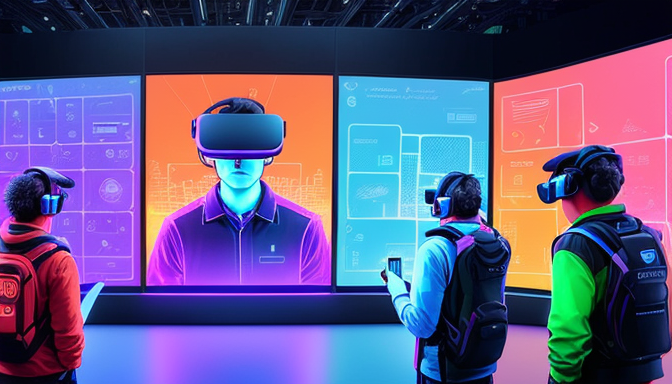Welcome to the exciting world of Virtual Reality (VR) and Augmented Reality (AR), where the boundaries of imagination are being pushed like never before! Have you ever dreamt of stepping into a video game or exploring a fantastical world right from your living room? Well, with the rapid advancements in these technologies, that dream is becoming a reality! The metaverse is not just a buzzword; it’s a whole new universe filled with endless possibilities for entertainment, socializing, and learning.
Imagine donning a VR headset and finding yourself in a breathtaking landscape, where you can interact with lifelike characters and embark on thrilling adventures. Meanwhile, AR is seamlessly blending the digital and physical worlds, allowing you to see virtual objects in your real environment. Whether it’s a game that transforms your backyard into a battlefield or an educational app that brings history to life right in your classroom, the potential is limitless!
As we dive deeper into these immersive experiences, we can expect to see innovations that not only enhance gaming but also revolutionize how we engage with art, music, and even social interactions. The future is bright, and the realms of VR and AR are set to become integral parts of our everyday lives, transforming mundane moments into extraordinary experiences. So, are you ready to explore these new realms and discover the future of fun?
Innovative Applications of VR and AR
Virtual Reality (VR) and Augmented Reality (AR) are not just buzzwords; they are transformative technologies that are reshaping our world in extraordinary ways. Imagine stepping into a virtual metaverse where you can interact with friends, explore new environments, and even attend concerts—all from the comfort of your home. This is not science fiction; it’s happening now! The applications of these technologies span across various sectors, making them a vital part of our future.
In the gaming industry, VR and AR create immersive experiences that pull players into fantastical worlds. Games like Beat Saber and Pokémon GO are just the tip of the iceberg. They allow players to engage with their surroundings in ways that were previously unimaginable. Beyond gaming, education is also being revolutionized. Imagine students being able to walk through ancient civilizations or conduct science experiments in a virtual lab. This kind of hands-on learning is not only engaging but also significantly enhances retention.
Moreover, the healthcare field is reaping enormous benefits from these technologies. Surgeons can practice complex procedures in a safe, virtual environment before performing them on real patients. This not only boosts confidence but also improves patient outcomes. In tourism, AR can enhance travel experiences by providing real-time information about historical sites, making every visit more enriching.
As we explore these innovative applications, it’s clear that VR and AR are set to redefine our interactions with the world. The possibilities are endless, and as technology evolves, so too will our experiences.

Challenges and Limitations of VR and AR
As we dive deeper into the thrilling worlds of Virtual Reality (VR) and Augmented Reality (AR), it’s essential to recognize the challenges that accompany these groundbreaking technologies. While the potential for immersive experiences is vast, several hurdles remain that could hinder their widespread adoption. For instance, accessibility is a significant concern. Not everyone has the financial means to invest in high-end VR headsets or AR devices, which can limit participation in these exciting realms.
Moreover, technical limitations can dampen the experience. Imagine donning a VR headset only to encounter lag or poor graphics—it’s like trying to enjoy a blockbuster movie on a tiny screen! Developers are constantly working to enhance hardware and software, but challenges like latency, resolution, and field of view still need to be addressed.
Another pressing issue is user safety. As people immerse themselves in these virtual worlds, they may lose awareness of their physical surroundings, leading to accidents. This concern is particularly relevant in public spaces or crowded environments. Developers must prioritize user safety to ensure that these technologies can be enjoyed without risk.
In summary, while the future of VR and AR is undeniably bright, overcoming these challenges is crucial for unlocking their full potential. The journey ahead may be rocky, but with innovation and dedication, we can look forward to a world where immersive experiences are as accessible and safe as they are exhilarating.
Frequently Asked Questions
- What is the difference between VR and AR?
Virtual Reality (VR) immerses you completely in a digital environment, while Augmented Reality (AR) overlays digital elements onto the real world. Think of VR as stepping into a video game, whereas AR is like adding a fun filter to your surroundings!
- How can VR and AR enhance education?
These technologies create interactive learning experiences that can captivate students. Imagine exploring ancient civilizations or conducting virtual science experiments without leaving the classroom. It’s like bringing the textbook to life!
- Are there any risks associated with using VR and AR?
Yes, there are some challenges, such as motion sickness or eye strain. It’s essential to take breaks and ensure a safe environment while using these technologies, much like you would when playing a video game for too long.
- What industries are benefiting from VR and AR?
From healthcare, where surgeons practice procedures in a virtual environment, to tourism, allowing virtual tours of far-off places, the possibilities are endless! These technologies are revolutionizing how we engage with various fields.
- How accessible are VR and AR technologies?
While they are becoming more widespread, accessibility remains an issue. Many devices can be pricey, and not everyone has the infrastructure to support them. However, as technology advances, we hope to see improvements in this area!